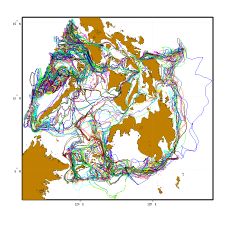Coastal Modeling
Quantifying Regional Ocean Dynamics on Multiple Scales
The MIT Center for Ocean Engineering is advancing the development and application of ocean models for coastal applications. The vision is to develop and transform ocean modeling and data assimilation to quantify regional ocean dynamics on multiple scales. MSEAS (the Multidisciplinary Simulation, Estimation and Assimilation System) leads this development thrust.
The MSEAS Group creates and utilizes new models and methods for multi-scale modeling, uncertainty quantification, data assimilation, and the guidance of autonomous vehicles. They then apply these advances to better understand physical, acoustical and biological interactions.
Multidisciplinary Simulation, Estimation, and Assimilation System
MSEAS, which has evolved over many years of research, is used to study, quantify, and predict tidal to mesoscale processes and physical-biogeochemical interactions over multi-resolution domains in many coastal regions of the world’s oceans. For physics, MSEAS contains both hydrostatic and non-hydrostatic codes; for biology, a generalized adaptable biogeochemical modeling system with varied options for biological parameterizations and components. Capabilities include implicit two-way nesting. A high-order finite element code on unstructured grids is built for non-hydrostatic physics and biogeochemical dynamics at shelfbreaks.
Other MSEAS subsystems include initialization schemes; nested data-assimilative tidal prediction; fast-marching coastal objective analysis; stochastic sub-grid-scale models; data assimilation; optimization and adaptive sampling; dynamically orthogonal equation for uncertainty predictions; non-Gaussian assimilation using Gaussian Mixture Models; machine learning of model structures and functions; and Lagrangian Coherent Structures.







